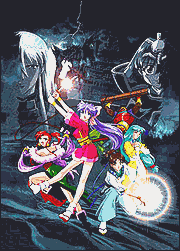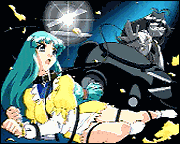 |


DANCING BLADE: KATTE NI MOMO TENSHI
Copyright © 1998 Konami Computer Entertainment
Sony PlayStation (3 CD-ROMs)
Interactive Story
1 Player
SLPM 86100~2
¥5800
Available now in Japan
Where to buy
FAQ
—by Mark Johnson



|
 |

DANCING BLADE is another in the long list of interactive story video
games—meaning it essentially consists of sitting back and watching the
action. However, this game's animation quality and content is worthy of a
closer look.
 The story pokes fun at a few Japanese legends, and its main characters are
loosely based on the story of Momotaro; the traditional tale of the Peach
Boy. Instead of a boy, the main character is a cute (and bouncy) girl named
Momohime (or "Peach Girl") who was born from a peach. Her traveling
companions are Kijime, a seductive woman who combines the personalities of
TENCHI MUYO's Ayeka with Urd from AH! MY GODDESS; Oinu, a sweet
magician/priest girl with good intentions but not always the best
execution; and Sarukichi, a lightly mechanized giant man. The player
(unnamed) is a male teenage magician who is, of course, desired by the
females of the group. The story pokes fun at a few Japanese legends, and its main characters are
loosely based on the story of Momotaro; the traditional tale of the Peach
Boy. Instead of a boy, the main character is a cute (and bouncy) girl named
Momohime (or "Peach Girl") who was born from a peach. Her traveling
companions are Kijime, a seductive woman who combines the personalities of
TENCHI MUYO's Ayeka with Urd from AH! MY GODDESS; Oinu, a sweet
magician/priest girl with good intentions but not always the best
execution; and Sarukichi, a lightly mechanized giant man. The player
(unnamed) is a male teenage magician who is, of course, desired by the
females of the group.
 The world itself is a fantasy-Japan; more so than SAKURA TAISEN, for
instance. Magic and technology are casually mixed with traditional style
architecture and dress. The world itself is a fantasy-Japan; more so than SAKURA TAISEN, for
instance. Magic and technology are casually mixed with traditional style
architecture and dress.
 The main story revolves around the theft of a valuable object in the
capital. Our gang decides to help battle the strange demons responsible.
Momo herself is motivated by the prospect of discovering more about her
past, and later meets Nayotaki, a little magician girl who was born from a
bamboo tree. The game's other subplots are mainly character driven. The main story revolves around the theft of a valuable object in the
capital. Our gang decides to help battle the strange demons responsible.
Momo herself is motivated by the prospect of discovering more about her
past, and later meets Nayotaki, a little magician girl who was born from a
bamboo tree. The game's other subplots are mainly character driven.
 The game itself plays like a "Choose-Your-Own-Adventure" Book.
Occasionally the player is given a choice of phrases to say, which will
lead the video down different paths. There are really two main paths, based
upon the first question asked. Either you can eat a quick snack
(kibidabgo) and go off on the main story to fight the mysterious demons who
attacked the capital, or you can attempt to find a fancy restaurant and
deal with all the misadventures that entails. All the other questions are
normally either different scenes that lead you back to the main path
instantly, or the occasional longer sidetrack. For instance, you can
choose to stay and wait for a battleship, or take a break on the beach
while waiting. One of my favorites is when your character feels an
explosion and either comments that "it's an attack" (leading to a big
battle), or "it's a travelling onsen" or hot spring (leading to a standard
bath scene); not your obvious choices. The game itself plays like a "Choose-Your-Own-Adventure" Book.
Occasionally the player is given a choice of phrases to say, which will
lead the video down different paths. There are really two main paths, based
upon the first question asked. Either you can eat a quick snack
(kibidabgo) and go off on the main story to fight the mysterious demons who
attacked the capital, or you can attempt to find a fancy restaurant and
deal with all the misadventures that entails. All the other questions are
normally either different scenes that lead you back to the main path
instantly, or the occasional longer sidetrack. For instance, you can
choose to stay and wait for a battleship, or take a break on the beach
while waiting. One of my favorites is when your character feels an
explosion and either comments that "it's an attack" (leading to a big
battle), or "it's a travelling onsen" or hot spring (leading to a standard
bath scene); not your obvious choices.
 Depending on the choices you make during the story, you may get one of four
endings, loosely based on how nice you are to each character. And each
time you "finish" the game, more options open up—like a Digital Art
Gallery, interviews, or Director's Cuts (which involve no interaction on
the player's part to watch). And once you have seen a scene, you can jump
directly to it from the main menu. Depending on the choices you make during the story, you may get one of four
endings, loosely based on how nice you are to each character. And each
time you "finish" the game, more options open up—like a Digital Art
Gallery, interviews, or Director's Cuts (which involve no interaction on
the player's part to watch). And once you have seen a scene, you can jump
directly to it from the main menu.
 The animation quality itself is surprisingly good, and the voice acting
brings no complaints from me. DANCING BLADE also sports a standard opening
theme and credits, very much like any traditional anime. The animation quality itself is surprisingly good, and the voice acting
brings no complaints from me. DANCING BLADE also sports a standard opening
theme and credits, very much like any traditional anime.
 So overall, DANCING BLADE is mainly anime on a PlayStation disk. The
multiple paths equate to about two 30-minute OVAs, and the animation
quality (although MPEG-ed) is definitely of tape quality. This makes it
seem more like an anime purchase than a video game purchase (although the
extras are a nice touch). It was popular enough in Japan to spawn another
"episode," which you can check out on the
Momotenshi Official Homepage
(in Japanese). For translations and more info, be sure to look at this page at
http://users.intercomm.com/hidalgo/dancemain/. So overall, DANCING BLADE is mainly anime on a PlayStation disk. The
multiple paths equate to about two 30-minute OVAs, and the animation
quality (although MPEG-ed) is definitely of tape quality. This makes it
seem more like an anime purchase than a video game purchase (although the
extras are a nice touch). It was popular enough in Japan to spawn another
"episode," which you can check out on the
Momotenshi Official Homepage
(in Japanese). For translations and more info, be sure to look at this page at
http://users.intercomm.com/hidalgo/dancemain/.
 So if you're interested in a light story with cute characters, much in the
vein of the lighter side of TENCHI MUYO or SAKURA TAISEN (or the 2nd RANMA
Movie), DANCING BLADE is well worth looking at. It's a fun, happy story
that knows its audience wants the occasional bit of "fan service." So if you're interested in a light story with cute characters, much in the
vein of the lighter side of TENCHI MUYO or SAKURA TAISEN (or the 2nd RANMA
Movie), DANCING BLADE is well worth looking at. It's a fun, happy story
that knows its audience wants the occasional bit of "fan service."

Rating: 7/10 |
 |

